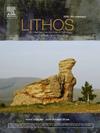The source of mafic post-collisional magmatism in the Southern Variscan domain: Insights from the Permian dyke swarms of northern Sardinia
IF 2.5
2区 地球科学
Q2 GEOCHEMISTRY & GEOPHYSICS
引用次数: 0
Abstract
Early Permian post-collisional magmatism is widely spread in southern Europe and it is represented by both felsic and mafic occurrences. One of the best places to observe such magmatism is northern Sardinia, where felsic Late Carboniferous-Early Permian batholiths are intruded by a large number of mafic dyke swarms. This study focuses on several dykes of mafic and intermediate composition from the Gallura region (northern Sardinia, Italy) that were emplaced during the extensional event(s) related to the collapse of the Variscan orogen. Based on textural, chemical and isotopic data the dykes are divided into three groups. Group 1 and Group 3 generally show calc-alkaline affinity, moderate to high enrichment in LREE over HREE, respectively, strong enrichments in LILE, Nb and Ta negative anomalies. Group 1 samples show more radiogenic Nd and less radiogenic Sr isotopic values compared to Group 3, while the two groups show similar Pb isotopic values. Group 2 shows depleted LREE and depleted Sr![]() Nd isotopic composition, relatively close to those of MORBs. Nonetheless, the negative Nb anomaly and Pb isotopic composition clearly distinct from those of MORBs highlight the subduction signature also in dykes from this group.
Nd isotopic composition, relatively close to those of MORBs. Nonetheless, the negative Nb anomaly and Pb isotopic composition clearly distinct from those of MORBs highlight the subduction signature also in dykes from this group.
Our modelling suggest that the distinctive geochemical features of the three groups are not related to closed-system fractional crystallization or to crustal assimilation, but they are the result of melting of a heterogeneous mantle source. Group 1 and 2 could have formed by melting of a peridotite at the transition of the spinel and garnet stability, with Group 1 possibly requiring a more enriched mantle composition and generally lower melting temperature. By contrast, a peridotite-pyroxenite mixture or an amphibole peridotite is the most likely source of Group 3 dykes.
The widespread coeval Early Permian mafic dykes and intrusive bodies from Southern Europe show geochemical features that are quite similar to those of northern Sardinia dykes. The comparison shows that the most common magma-types are similar to Group 1 and subordinately to Group 3 from Sardinia, suggesting that most of the mafic Early Permian post Variscan magmatism was formed by melting a mantle that was enriched during the Variscan orogeny. On the contrary, Group 2-like magmatism is very scarce in southern Europe and its more depleted compositions are probably the result of decompression melting of asthenospheric mantle with a subtle subduction signature.
南Variscan域岩浆碰撞后岩浆活动的来源:来自撒丁岛北部二叠纪岩脉群的见解
早二叠世碰撞后岩浆活动在南欧广泛分布,以长英质和镁质岩浆活动为代表。观察这种岩浆活动的最佳地点之一是撒丁岛北部,在那里,晚石炭纪-早二叠纪的长质岩基被大量的基性岩脉群侵入。本文研究了意大利撒丁岛北部Gallura地区的几条基性和中间成分的岩脉,这些岩脉是在与Variscan造山带崩塌有关的伸展事件期间形成的。根据结构、化学和同位素资料,将岩脉分为三组。第1组和第3组总体呈钙碱性亲和性,LREE比HREE富集中~高,LILE、Nb和Ta负异常富集较强。与第3组相比,第1组样品显示出更多的放射性Nd和更少的放射性Sr同位素值,而两组样品的Pb同位素值相似。组2显示贫LREE和贫SrNd同位素组成,与morb相对接近。尽管如此,该岩脉的负Nb异常和Pb同位素组成与morb明显不同,突出了该岩脉的俯冲特征。我们的模拟表明,这三个类群的独特地球化学特征与封闭系统的分离结晶或地壳同化无关,而是非均质地幔源熔融的结果。第1组和第2组可能是在尖晶石和石榴石稳定性过渡时期由橄榄岩熔融形成的,第1组可能需要更丰富的地幔成分和普遍较低的熔融温度。而第3组脉岩最可能的来源是橄榄岩-辉石岩混合物或角闪孔橄榄岩。同时期欧洲南部广泛分布的早二叠世基性岩脉和侵入体的地球化学特征与撒丁岛北部岩脉非常相似。对比结果表明,撒丁岛最常见的岩浆类型与第1组相似,从属于第3组,表明大部分早二叠世基性后瓦里斯坎岩浆活动是由瓦里斯坎造山运动期间富集的地幔熔融形成的。相反,在南欧,类2群岩浆活动非常稀少,其较弱的成分可能是软流圈地幔减压融化的结果,具有微妙的俯冲特征。
本文章由计算机程序翻译,如有差异,请以英文原文为准。
求助全文
约1分钟内获得全文
求助全文
来源期刊

Lithos
地学-地球化学与地球物理
CiteScore
6.80
自引率
11.40%
发文量
286
审稿时长
3.5 months
期刊介绍:
Lithos publishes original research papers on the petrology, geochemistry and petrogenesis of igneous and metamorphic rocks. Papers on mineralogy/mineral physics related to petrology and petrogenetic problems are also welcomed.
 求助内容:
求助内容: 应助结果提醒方式:
应助结果提醒方式:


